Prime rib is a show-stopping roast best reserved for special meals. While an expensive cut, smoked prime rib easily delivers the finest, most flavorful beef if cooked properly. The key is taking it low and slow.
We use a reverse sear technique: gentle smoking to cook the interior perfectly, followed by searing to develop an incredible crust. The result – incredibly tender, edge-to-edge pink meat infused with subtle smoky essence. Far better than any prime rib from an oven.
Follow our guide to maker this special-occasion roast into your new go-to wow factor meal for guests. We walk you through every step to achieve prime rib perfection with zero stress or guesswork. Get ready for the best prime rib – ever.
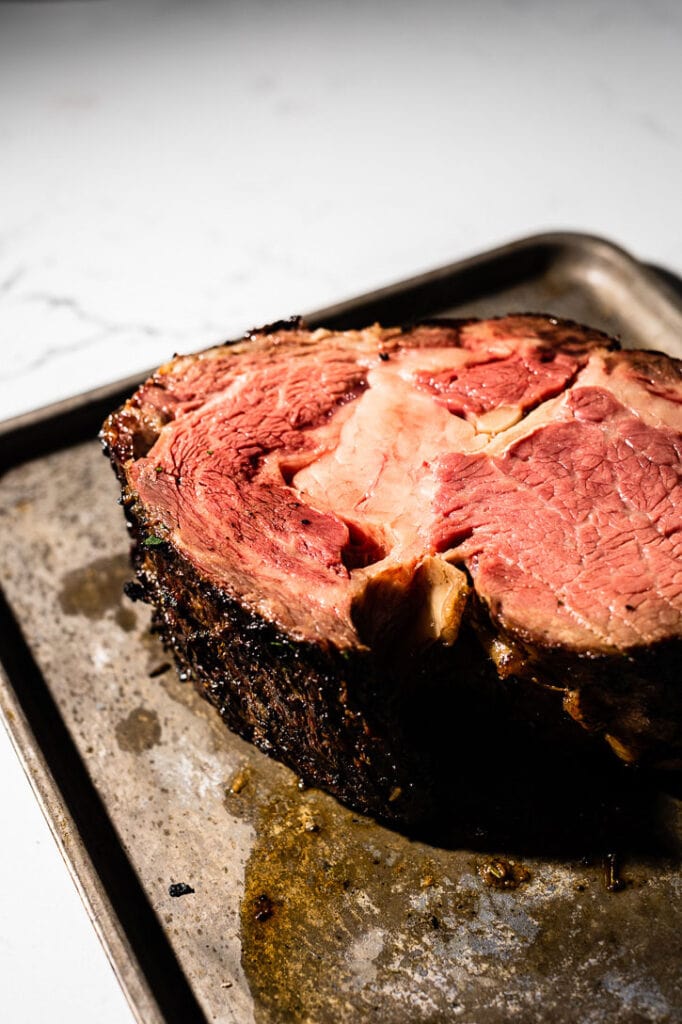
What You’ll Need: Tools & Equipment
- Butcher twine – Use it to tie the roast into a uniform shape, or to tie the bones back onto the roast.
- Remote probe thermometer – Remotely monitors the internal temperature of the roast and your smoker so you don’t have to keep checking on it.
- Thermapen instant-read meat thermometer – Use it to spot-check and verify the internal temperature.
- Sheet pan + rack – For seasoning the roast.
- Wood chunks or pellets – Oak is my favorite for beef, but pecan and hickory are also great.
- Slicing knife
Choosing the Best Rib Roast
While called “prime rib”, the name refers to the primal cut rather than a USDA Prime grade. You can use Prime grade for maximum tenderness and flavor, but Choice grade also produces excellent results at a lower cost. Premium prime rib roasts can be purchased online from Snake River Farms. Your local butcher and Costco are also great options.
The terminology for this cut can be confusing. The rib roast is also known as standing rib roast or prime rib roast. When sliced, it becomes ribeye steaks, which may be boneless, bone-in, or tomahawk-style with the long bone still attached.
I recommend buying a boneless roast. The bones don’t add flavor, may cause uneven cooking, get in the way of seasoning, prevent searing all surfaces, and you still pay for their weight. Boneless is easier to carve and serve. If you can only find bone-in, ask your butcher to remove them or do it yourself and smoke the bones separately for bonus flavor.
Figure about 1-pound of uncooked rib roast per person, to provide a nice thick slice per person and enough for the amazing leftovers.
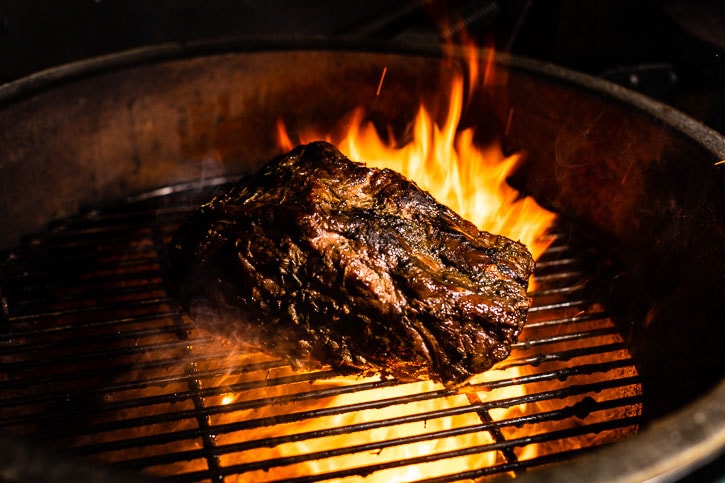
How to Smoke a Prime Rib
The best way to smoke a prime rib roast is to use the reverse-sear technique in the smoker. Jump down to the full recipe card for all the details.
- Season all sides of the roast with plenty of kosher salt and black pepper.
- Smoke the prime rib at a low temperature of 250° F for about 3 hours, or until the internal temperature reaches a target pull temp of 118° F for medium-rare.
- Remove and rest for 30 minutes.
- Sear the prime rib for 1 to 2 minutes on all sides on a super-hot grill, skillet or under the broiler (your choice) to develop a crusty and flavorful exterior..
- Slice against the grain into 1/2″ to 3/4″ slices and seve.and serve.
8 Keys to the Perfect Smoked Prime Rib
- Select at least USDA Choice grade for premium flavor and tenderness.
- Start early. Season heavily with koshwer salt and pepper 24-48 hours in advance. This deeply penetrates the meat for better texture and taste.
- Remove the rib bones to season, and tie them back on for cooking, if desired.
- Keep the flavors simple. This is the ultimate premium piece of beef when it comes to flavor, and you pay for that, so you don’t want to cover it up with a marinade or strong flavors. You can add a garlic and herb paste to the outside, but we’re keeping it simple with salt, pepper and the amazing flavor of the smoke. You won’t be disappointed.
- Allow roast to temper by sitting out for 2-3 hours before cooking to bring up the starting temperature for even cooking.
- Use a remote-probe meat thermometer and cook to temperature not time.
- Pull from smoker at 120°F internal for medium-rare after rest to avoid overcooking, which is about 10 degrees below the desired finished temperature.
- Don’t skip the 30-minute rest! This gives the roast time to re-absorb the juices so they don’t run out upon slicing.
A variation on the Cooking Method
Cooking rib roast sous vide first (usually for 24 hours) and then finishing it in the smoker is another great option for perfect results. Get the recipe for Smoked Sous Vide Prime Rib.
The Best Wood for Smoking Prime Rib
Hickory and oak woods work well for adding subtle smoke that compliments prime rib’s rich flavor. Post oak provides a sweeter, balanced smoke. Hickory brings a classic smokehouse taste. You can also try adding in some fruitwood like apple. For light smokiness, use 2-3 chunks over the coals, more if you prefer. Wood chunks may require ordering online, but are widely available.
The key is choosing a wood that provides a kiss of smoke without overwhelming the meat. We want just enough smoke presence to complement the delicious beefiness of prime rib. Strong mesquite smoke for example may cover that flavor instead of enhancing. Test out small amounts of different smoking woods to find the right level of smoky accent for your preferences.
Learn more about choosing the best woods for smoking meat.
Temperatures and Times
For ultimate tenderness and flavor, target an interior temperature of 130-134°F after resting. This delivers a reddish-pink medium-rare from edge to edge. Resist overcooking, as higher temperatures quickly dry out the meat.
Monitor temperature closely with a leave-in thermometer. Allow for carryover cooking of around 10° F by pulling it off heat slightly under the final target temp.
| Doneness | Pull Temp (10 to 15 degrees before target temp) | Target Finished Temp (after resting and searing) |
| Rare | 110-110° F | 120-129° F |
| Medium-Rare | 118-124° F | 130-134° F |
| Medium | 125-133° F | 135-144° F |
The approximate cook time for a 7-pound roast: 3 to 4 hours (25 to 30 minutes per pound)
Tips & Keys to Perfect Smoked Prime Rib
- Select the highest-grade prime rib you can afford for premium tenderness and flavor.
- Season very generously with 1 teaspoon of Diamond kosher salt per pound of meat. Apply 24-48 hours in advance so it fully penetrates. This is key for ideal texture and taste.
- Allow roast to temper before cooking by sitting out 2-3 hours to prevent uneven cooking.
- Use a leave-in remote meat thermometer and cook indirectly to temp not time. Pull at 120°F for med-rare.
- Never skip the 30-minute rest for juiciness and texture.
- Have your butcher trim and tie the roast for you to simplify the prep work.
- Slice against the grain for the most tender bites.
A Sauce to Bring It Together
Creamy horseradish is a wonderful cool contrast with a slight kick, au jus is classic with prime rib and can be made while your roast is in the smoker. It often includes the drippings, but I personally would omit them to give a non-smoke contrast to the meat. If you removed the rib bones, you could roast them and make homemade beef stock with them to use for the au jus or a red wine sauce. A rich bearnaise sauce is also wonderful with beef.
Perfect Sides to Serve with it
- Creamy Scalloped Potatoes
- Tender Green Beans
- Yorkshire Pudding
- Creamy Mashed Potatoes
- Grilled Broccolini
And if you have leftover prime rib, it is perfect in steak sandwiches the next day.
FAQs
It will take about 3 to 3 1/2 hours to smoke a 7-pound rib roast at 250° F (approximately 30 minutes per pound) for a medium-rare cook. Always cook to temperature and not strictly by time.
Oak or hickory are the best options to give great subtle flavor without overpowering the beef.
Yes, but preferably even earlier than that. Salt the rib roast at least one day, but even up to 3 days in advance, with 1 teaspoon of Diamond kosher salt per pound of meat. Learn more about when to salt meat.
Wine and Beer Pairings
Go big and bold with a wine pairing for this one. A hearty “big red” wine (like a Cabernet Sauvignon or Malbec) or a flavorful beer (like a Belgian brown or Flemish red) will complement the roast wonderfully.
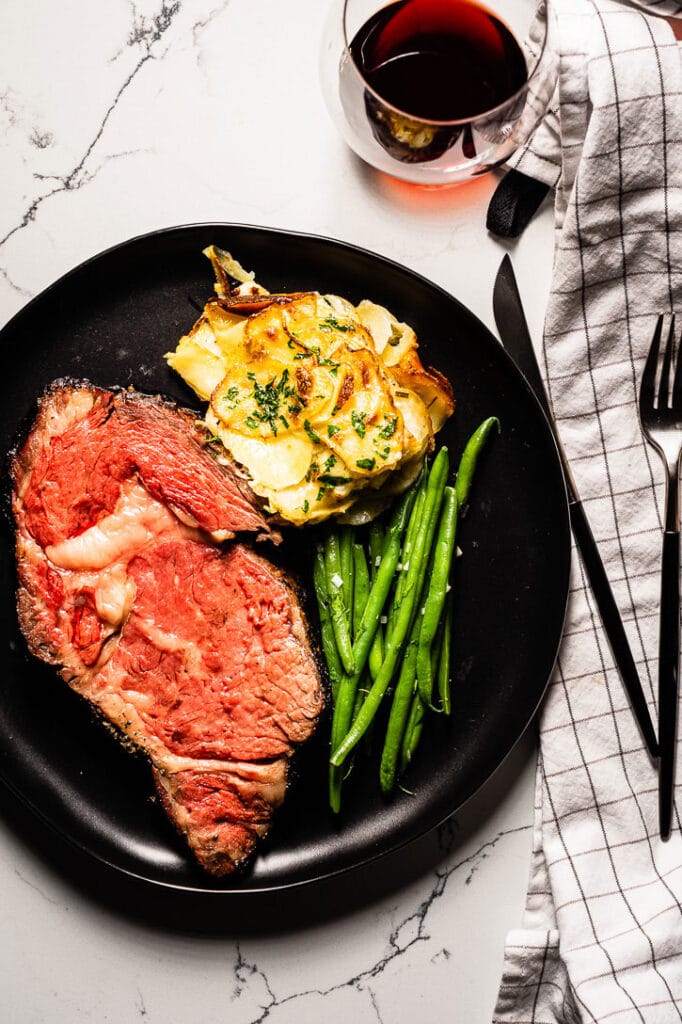
More Recipes You’ll Love
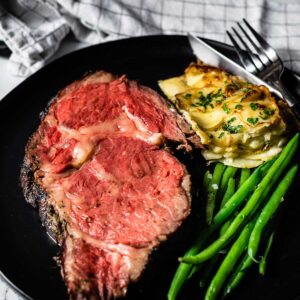
Smoked Prime Rib
Ingredients
- 1 boneless or bone-in rib roast (4-7 lbs)
- canola oil
- Diamond kosher salt (1 tsp per lb)
- black pepper
Instructions
Prep (1-3 days ahead)
- Pat the roast dry with paper towels. Trim the fat cap down to 1/4" on top if needed, and cut a crosshatch pattern in the fat cap. Remove the rib bones (if desired) using a sharp boning knife.
- Season: Lightly coat with oil and then generously season all sides with kosher salt (about 1 tsp per pound), and pepper. Refrigerate for 24-48 hours
- Use butcher twine to tie the rib roast so it is a nice round shape and cooks evenly. If desired, you can tie the rib bones back in place as well. I prefer to leave them off and smoke them separately or use them to make beef stock.
- Place the rib roast on a cooling rack on a baking sheet pan, then into the refrigerator uncovered for 24 to 48 hours (or even 3 days if you have time).
Smoke the Prime Rib
- Temper the meat: Remove the roast from the refrigerator to sit on the counter to temper for 2 to 3 hours prior to cooking.
- Set up your smoker for indirect cooking at 250° F (121° C) with a water pan in place according to the manufacturer's instructions. Use 2 to 3 oak wood chunks for charcoal smokers or pellets for a pellet smoker.
- Insert a leave in remote probe thermometer into the center of the roast and set the alarm to go off at 118° F for the pull temp for a medium-rare finish.
- Place the rib roast in the smoker and cook for approximately 25 to 30 minutes per pound (3 to 3 1/2 hours) until the internal temperature reaches 118° F (47° C) for medium-rare.
- Remove the roast from the smoker and rest uncovered for 30 minutes.
Sear
- Preheat grill, a heavy-bottom skillet or broiler on high (500° or 550° F).
- Sear for 1 to 2 minutes per side until dark and crusty, about 4 to 8 minutes total. (remove the tied on rib bones before searing). The finished temperature should be 130-134° F (54-56° C) for medium-rare
- Transfer to a large cutting board and rest it for 5 minutes before slicing against the grain into 1/2" to 3/4" pieces.
- Sprinkle with finishing salt and enjoy!
Notes
- Cook to temp not time.
- Slice only what will immediately be served
- Salt amount: 1 tsp per pound of beef (Diamond kosher). See the conversion chart for other types of salt.
- Temp chart:

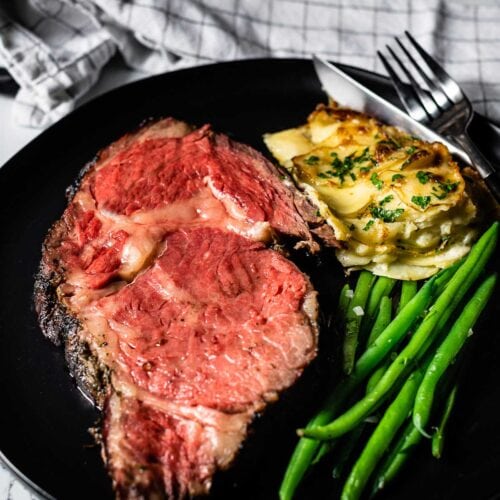
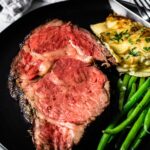
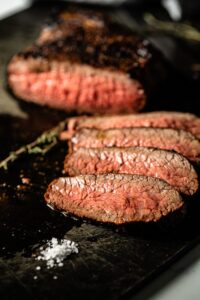
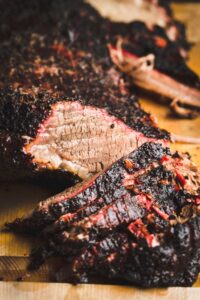
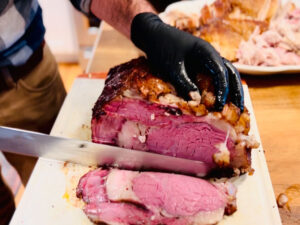
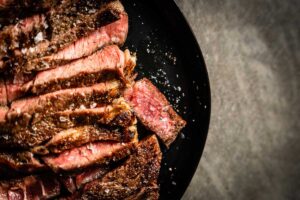

I made this for Thanksgiving, and just like your easy smoked brisket recipe, this one was fantastic! Even easier than the brisket, perfectly cooked, and we turned the leftovers into sandwiches the next day. Will absolutely be making this again!
Thank you for all your great, easy recipes. All the information included in the post is always so helpful.